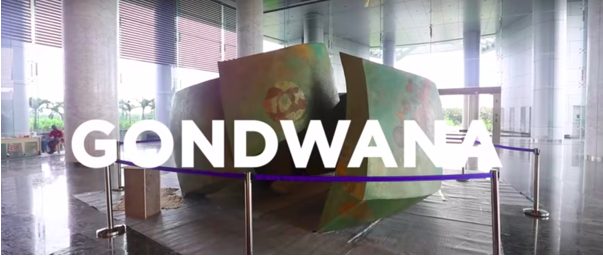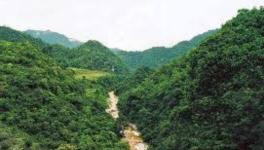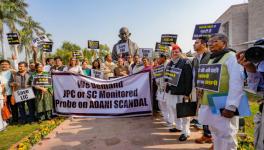Adani Group: Expropriating Indigenous Lands, Appropriating Indigenous Art?

‘Gondwana’ installation at Adani Group Headquarters, Ahmedabad, Gujarat; Image Source: Screen Grab, Facebook/AdaniOnline
A promotional video posted on November 4 by the Adani group’s social media channels describes a new art installation at Shantigram – at its headquarters in Ahmedabad in Gujarat – as “celebrating the aura and mystery of sacred geographies and memories.” A press note circulated by the group announcing its unveiling, terms it “an experiment in understanding creative collaboration with cross-cultural insights.”
Conceived by Padma Bhushan awardee Rajeev Sethi, an internationally acclaimed designer and artist, the installation is the first of 48 projects conceived under the Adani group’s ‘Art Programme at Adani Shantigram,’ according to the press release.
Sculpted and designed by Sethi, the installation is a collaboration with Indian artist Bhajju Shyam and Australian artists, Otto Jungarrayi Sims and Patrick Japangardi Williams, according to the note. Shyam is a Gond adivasi; Sims and Williams are members of the Australian Warlpiri indigenous community, the note emphasizes. Sims and Williams are members of the Warlukurlangu Artists Aboriginal Corporation, an indigenous owned art cooperative and centre in Yuendumu, Northern Australia. Shyam is an artist of worldwide acclaim, and was conferred a Padma Shri in 2018. The three collaborators painted the installation sculpted by Sethi. Waxing lyrical, the press release states the installation is “inspired by the sacred landscape of the indigenous people.”
Sethi, speaking to the Ahmedabad Mirror lauded the initiative by the Adani group, saying “for a major industrial house to be able to expand the creative space is so critical.” Gautam Adani, the group’s multibillionaire founder and chairperson, and the second richest man in Inda, is quoted in the press note as saying “the cultural exchange also reflects upon the historic bond between the two nations.”

Adani group chairman Gautam Adani and Priti Adani, chairperson of Adani Foundation and Sethi, Shyam, Sims and Williams and others pose before the installation at its unveiling at Shantigram, Ahmedabad; Image Source: Adani Group Press Release
An innocuous event by itself, when seen in the light of the Adani group’s industrial development projects in India and Australia that place it in direct conflict with indigenous communities, acquires a darker hue.
The Battle for Hasdeo Arand
In three coal blocks and a power plant in Chhattisgarh, all located in the Hasdeo Arand forest, the Adani group, aided by multiple state and central government bodies has pulled off a legal and regulatory coup to deny adivasi residents, mostly Gond adivasis, democratic rights to their lands and forests.
The Adani group currently runs a mining operation as a contracted supplier of coal to the Rajasthan government’s power corporation, Rajasthan Rajya Vidyut Utpadan Nigam Limited (RRVUNL) in the Parsa East and Kanta Basan coal block in Surguja district, Chhattisgarh. A power plant by the group is proposed in the same block.
Two further coal blocks named Kente Extension and Parsa, adjacent to the existing mine, have also been allocated to RRVUNL, which has in place agreements with Adani group companies to conduct mining operations. These projects are all located in the Hasdeo Arand forest in Chhattisgarh, and have faced an organised movement of opposition from the adivasi communities, so far to little avail.
The areas of concern that have led to an anti-coal mining movement in the region include environmental destruction, destruction of livelihoods, displacement and denial of property and forest rights, and subversion of democratic self-governance.
The RRVUNL had been allotted the Parsa East and Kanta Basan coal block as a captive mine to supply coal to power plants it operates in the state. In 2007, it set up a joint venture with an Adani group company to mine the block and supply the coal to it. Under the legal arrangement, while RRUVNL was the owner of the mine, the joint venture that is majority owned by an Adani group company, was the ‘mining and development operator.’ This company would obtain the necessary permissions and land, set up and operate the mine, and sell the coal to the RRVUNL.
However, in 2009 the entire Hasdeo Arand forest was declared a ‘no-go’ area for industrial projects that would involve deforestation and environmental disruption by the Union Ministry of Environment and Forests (now the Ministry of Environment, Forests and Climate Change). In 2011, the Forest Survey of India, an agency of the Environment Ministry, declared Hasdeo Arand the largest uninterrupted tract of forest anywhere in central India beyond protected areas.
However, under pressure from the Rajasthan government and the Union Coal Ministry, the Environment Ministry scrapped the use of the ‘no-go’ classification in 2012. The same year, environmental clearance and forest clearance were granted to the project, permitting mining operations to begin.
By law, before handing over the block to the company to mine coal and issuing it a mining license, the Chhattisgarh government needed to settle all residents’ claims to the land. In addition to individual land titles, local residents were also entitled to assert title rights over the forest commons under the Forest Rights Act (FRA), and the right to permit or disallow mining activity by democratic means under the paradigm of local self-governance guaranteed by the Provisions of Panchayat (Extension to Scheduled Areas) Act (PESA).
While the environment clearance given to the project was challenged before the National Green Tribunal (NGT) by Raipur-based lawyer and activist Sudiep Shrivastava, multiple claims over land titles and forest rights over commons land were raised by local residents. However, the state government issued a mining license in 2012 even as all such claims were still pending.
After mining started in 2013, residents of a village in the block named Ghatbarra, won official recognition of their community rights over forest land under the Forest Rights Act. In 2014, the NGT ruling on Shrivastava’s petition cancelled the forest clearance granted to the project. On appeal of the tribunal’s order though, in less than a month’s time, the Supreme Court permitted mining to continue, while it heard the appeal.
A few months later, also in 2014, in a ruling on the “Coalgate” scam relating to improper allocation of coal blocks to private companies by the Central government, the Supreme Court (SC) cancelled nearly all the existing permissions for mining of coal blocks by private companies, including the Parsa East and Kanta Basan block.
As per the apex court’s orders, these blocks had to be put up for auction by the government. While almost all the blocks covered by the order proceeded to do so, the Rajasthan power generator managed to merely renew its existing arrangement with the Adani group, despite the same arrangement having been deemed illegal in the apex court’s order.
A few months after the apex court’s order, the gram sabhas of villages in the affected block passed a resolution opposed to further land acquisition for mining and auctioning of mining rights in the forest region, copies of which were sent to the then Chief Minister of Chhattisgarh, Raman Singh, and Prime Minister Narendra Modi. The representatives of the sabhas asserted their community rights over the land and forest under the FRA and their right to assert their stake in the decision-making process under PESA. Under PESA, the government is mandated to take the gram sabhas’ prior permission to acquire land in scheduled areas.
Mining at the block never stopped throughout this period though. In 2016, the district administration of Surguja unilaterally issued an order cancelling the community forest rights that the Ghatbarra residents had earlier secured official recognition of. The order stated “when the administration tries to get diversion of forests done for the Parsa East and Kanta Basan coal block, the villages, using the pretext of the land rights given to them by the collector, create barriers and protest to stop the work.”
Detailed reports by, among others, Caravan magazine, Land Conflict Watch, People’s Archive of Rural India, Centre For Policy Research, the Pulitzer Center, and by independent academics and activists, can be referred to by the interested reader to understand the intricacies of the issue in depth.
Adivasis’ Fight to Protect Hasdeo Arand
On the ground, the fight against the existing and proposed projects has mostly been conducted by adivasi communities. Speaking to independent journalist Chitrangada Choudhury in an interview for the Caravan, Jainandan Singh Porte, a member of the Hasdeo Arand Bachao Sangharsh Samiti (HABSS), the co-ordinating body spanning 40 villages in the region that is leading the struggle, said “forests are our sanskruti [culture] and our livelihood. Hasdeo gives us so many products and food—mahua, sal, tendu patta, chironji, khunkdi, and lakdi [forest produce such as leaves, seeds, mushrooms and firewood].
Tendu leaves can give adivasi households an income of Rs 60,000-70,000 per household each year. Why do authorities not see all this when they decide to give clearance to mining? Hasdeo is our only home. If we give this forest, where will we go? We can never get it back.”
Adivasi residents of the region who are active in anti-Adani movements are routinely termed as Maoists by the police and state government, and face a mix of police encounters, political imprisonment, and false cases against them. Activists and lawyers advocating the cause against coal mining have also faced a variety of attacks and attempts to curtail their liberty. Here are a just a few examples.
Sudha Bharadwaj, who had been fighting the legal battle as the advocate for the village residents of Ghatbarra who had seen community forest rights secured by them summarily cancelled by government, was arrested in 2018 on charges of having links to Maoists.
Podiya Sori and Lachu Mandavi two “young and respected leaders...who had been active in the popular movement against the plans of the mining giant Adani group” were killed in police firing on September 13, 2019 in what was termed a fake-encounter by a citizen’s fact-finding group. The police termed them members of the banned Maoist movement.
Prominent community leader, Soni Sori, an ever-present figure in adivasi movements against corporates operating in central India, has been a significant presence in adivasi protests against the Adani group. She was one of the authors of the citizens’ report on the September 13 encounter, and conducted public meetings on the issue. Soon afterwards, police cases were lodged against Sori and academic and activist, Bela Bhatia, co-author of the report, and around 150 persons who conducted a protest three days after the encounter at a police station, where the two activists handed over their report on the incident.
On October 5, when Sori was due to participate in a public meeting on the release of adivasis from various jails, she was arrested by the Chhattisgarh police.
On October 31, it was revealed that a number of Indian activists and members of civil society had faced digital surveillance of their mobile phones, by use of an Israeli spyware, Pegasus, which the digital messaging company WhatsApp named as the mode by which civil society members across the world had been targeted for surveillance. Among the Indian names of targeted activists were those of Bhatia and Alok Shukla, convenor of the Chhattisgarh Bachao Andolan, a nodal civil society organisation that the HABSS is a member of. Shukla happens to be the petitioner in an eight-year-long court battle against the Adani group, related to its coal mine.
At the time of writing, the HABSS was protesting for over a month against the Chhattisgarh government’s continuing refusal, even under the newly elected Congress government under Chief Minister Bhupesh Baghel, to respect the resolutions passed by the gram sabhas.
The demand by the HABSS is that no mining project should be given land in the forest region, and that land acquisition already initiated in some villages in the Surguja and Surajpur districts be scrapped. They point out that despite a change in the state government in the 2018 election, when the Congress came to power with Baghel as Chief Minister, and a 2015 pledge by Rahul Gandhi that the Congress stood by their protest against the coal mines, there has been no change in the Chhattisgarh government’s position.
Hasdeo Arand Bachao Sangharsh Samiti Reacts
Reacting to the news of the Adani group’s patronage of the ‘Gondwana’ installation and the publicity relating to it, HABSS convenor Umeshwar Singh Armo told Newsclick over the phone: “If on the one hand they [Adani group] are destroying adivasi art by destroying adivasi society, and on the other they claim to be celebrating and furthering adivasi art by making such a piece, then clearly they are wrong.”
“We definitely oppose it. If you tear away some aspect of adivasi art and put it on paper or a structure to depict it somewhere, then you are unfortunately not furthering it at all. Development of art cannot happen this way. First adivasi life and culture has to be secure, only then can something like this be helpful. I think Adani is doing this to show people in other areas that they want to mine, that they are doing something for the people affected by their mines. In fact, there is no such thing,” he continued.
“Consider this: in the environmental impact and social impact reports that they prepare for public hearings, on the basis of which they ask for our consent to acquire our land, they talk about trees and wildlife in the area, but these reports have no mention of how the forest is central to adivasi life,” he added.
“For instance, there are several plants and trees that carry certain ritual significance. The Karmi plant that adivasis pray to at the Karma festival, the Tad plant is prayed to by adivasis for their ancestors. There are numerous such examples that find no mention in any of these reports. You claim you will save the environment, but don’t even understand the adivasi environment, how can you promote adivasi art? It does us no good, they will keep doing such things for their own reasons” Umeshwar said.
Adani in Australia
On October 22, the Adani group in Australia obtained an order from the Supreme Court of the state of Queensland to prevent two indigenous activists from entering the site of a proposed coal mine that it owns. The two activists, Adrian Burragubba and his son, Coedy McAvoy, are members of the Wangan and Jagalingou (W&J) indigenous community, which is recognised under Australian law as a ‘First Nation.’
Under the Australian system of recognition of indigenous sovereignty and claims on ancestral lands, the peoples of First Nations are entitled to rights on lands that they have traditionally lived in. The mine owned by the Adani group lies in the lands of the W&J nation. While the W&J people have consistently opposed the mine, in a parallel to how the Chhattisgarh administration unilaterally cancelled the claims made by adivasi residents of Hasdeo Arand under the FRA, the Queensland government in August 2019 quietly cancelled the title rights of the W&J people over the area of the Adani owned mine, without notifying the traditional owners.
Burragubba and McAvoy, along with other members of the organisation Wangan and Jagalingou Family Council, that has organised the W&J people who will be displaced and affected by the mine, had set up a camp site for activists and community members inside the land allocated to the Adani owned mine. After the Queensland government’s order to extinguish the W&J Nation’s title rights over the mine, the Adani group warned Burragubba that he had trespassed on Adani group property.
According to Australian media reports, a few days later, security guards engaged by the Adani group filmed a verbal confrontation with Burragubba and McAvoy at the campsite, and that footage was presented to the Queensland Supreme Court to procure an order that not only directed Burragubba and McAvoy to cease trespassing on the land, but also opened up the possibility of the arrest of any W&J community member visiting their lands in the site without prior authorisation by the Adani group company.
The tide turned for the Adani group’s massive project of setting up a coal mine, a railway line and a port in Australia only over the course of 2019, nearly a decade after it first entered the country. The Carmichael coal mine as it is named, is set to be the largest coal mine in Australia and one of the largest in the world. It is located in the Galilee basin in Queensland, and is planned to produce 60 million tonnes of coal a year for 60 years, most of it for export to India.
The Adani group is also supposed to build a railway line to transport coal from the mine to the Abbott Point port, which it has also acquired. In the nine years that the group has been in Australia, it has only so far been able to successfully take over the Abbott Point port – the remaining prongs of the project have faced a range of civil society opposition and other hurdles. In addition to the W&J people, a coalition of farmers, environmental activists, and other civil society groups have come together in opposition to the mine, in a debate that has polarised mainstream politics in the country.
The Adani group mine is supposed to be the first of six coal mines that have been allocated in the same Galilee basin. Once all six are open, the mines, the railway and the port, as a commercial complex are expected to be a thriving source of employment, and a major revenue generating asset for the group. However, this project has been controversial from its very inception, with a growing focus on reducing energy dependence on coal due to the threat of climate change. While coal is a major export for the country, Australia has also committed under the 2015 Paris Agreement to phase out coal production altogether.
Till last year, it looked like the opposition was winning the battle. Major international banks and insurers were wary of funding the project, with many having declared policies that they would no longer invest in coal. A proposed $1 billion (Rs 6,200 crore) loan by the State Bank of India that had been announced while Prime Minister Narendra Modi visited Australia in 2014, with Gautam Adani accompanying him, later fell through.
The native title and sovereignty system in Australia meant that the consent of the people of W&J First Nations was mandatory for the mine to go through. It also stood as a robust barrier with the community persistently opposed to the project. In addition, several clearances that the mine would require before the Adani group company could begin operations were stuck in litigation due to environmental objections, and a fierce public campaign carried out under the slogan “Stop Adani” had turned the Carmichael mine into a symbol for the larger debate on climate change, and had come to represent one of the central wedge issues of all of Australian national politics.
In June though, the cards began to fall into place as Adani Australia declared that it had obtained all the clearances that it required for the Carmichael mine to begin operations. In July, a Federal Court upheld an ‘Indigenous Land Use Agreement’ that signified the assent of the W&J Nation to Adani’s use of its land.
While the government and Adani insist that the W&J signatories to the agreement are authorised and legitimate representatives of the W&J Nation, the WJFC has called it a “sham” agreement. They have questioned whether the signatories are entitled under the laws and customs of W&J people to make that decision to sign away W&J rights in land for monetary compensation.
Indian readers may recognise the known practice in India for companies to enlist their own paid ‘community representatives’ to attend public hearings and grant ‘consent’ on behalf of local communities, without consulting the actual local community, or employ a variety of such tactics to subvert the requirement to obtain the resident population’s consent. The WJFC’s claim is comparable.
Soon thereafter, in August, with the Queensland government’s voiding the W&J Nation’s title rights, the site was open for the Adani group to take possession of. As things stand, mining is expected to begin at the site soon though the WJFC has committed to continuing the struggle against the Adani group.
Response From the W&J Family Council
It is against this backdrop that the conglomerate’s awakening as a patron of Australian indigenous art is being seen by the WJFC.
Reacting to the launch of ‘Gondwana’ at the Adani group’s Ahmedabad headquarters, Adrian Burraguba, on behalf of the WJFC sent the following statement to Newsclick
When “art meets business” in Adani’s case, it can only highlight the way in which genuine creativity and cross-cultural engagement is bought and paid for to mask the corporate conglomerate’s damaging dealings with Indigenous and traditional communities.
W&J are First Nations people with strong art, culture and law, dating back tens of thousands of years through our ancestral connection to our lands and waters. We respect the artists Otto Jungarrayi Sims and Patrick Japangardi Williams, who collaborated with Gond artist, Padma Shri Bhajju Shyam.
‘Gondwana’, may be an artwork that brings art of India and Australia together, but Adani’s corporate presence in Australia is one that divides communities, destroys our sacred sites, plunders our lands and waters for his own profit, and denies us our internationally guaranteed human rights.
We know there are traditional communities in India who are feeling the brunt of the same corporate attack our people are. Gautam Adani's mining company will drastically impact the lives of India's Adivasis, including the Gond after whom Gondwana was named, as he proceeds to destroy their home in the Hasdeo Arand forest for coal, and subjugate their resistance to this destruction.
The Adani corporation plans to ship the coal from our country in Australia to Godda in eastern India, where it is dispossessing tribal people from their lands, destroying farmers livelihoods and disregarding human rights to get its power station built.”
No Response From Rajeev Sethi
Newsclick reached out via email to Rajeev Sethi for his comment first on November 8, followed by sending him written questions via email on November 13. No response was received at the time of publication; this article will be updated if a response is received.
The author is an independent journalist based in Mumbai. The views are personal.
Get the latest reports & analysis with people's perspective on Protests, movements & deep analytical videos, discussions of the current affairs in your Telegram app. Subscribe to NewsClick's Telegram channel & get Real-Time updates on stories, as they get published on our website.
























